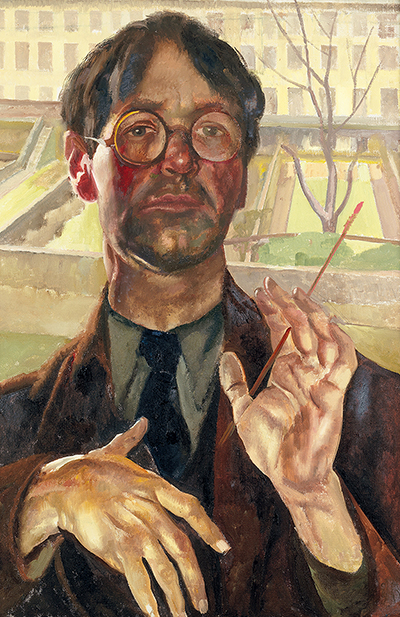Stanley Spencer painted a mirror image of himself in July 1939. He loved his life and took himself as the subject of his work on many occasions. The Self Portrait, Adelaide Road 1939 is at Fitzwilliam Museum (University of Cambridge) Cambridge, UK.
The artist used oil and canvas to make a self-portrait using the neo-romanticism style. He displayed remarkable skills in this creation to deliver a series of wonderfully honest expression of himself. The painting depicts a worried Spence in a self-scrutinizing image. He holds a painting brush and appears wearing a coat, tie, and collar. The art reconfirms his status as one of the most exceptional artists with a unique happy vision for the world. The walls and the building in the painting are covered with life-affirming colours in an attempt to cheer him up in these troublesome times. His look portrays deep thoughts and intense emotions.
He doesn't seem to shrink into his life's pain, but instead, the art is full of hope. He worked with tinny brushes to capture perfect colour patterns and texture to reflect the intricate details in his artwork. The painting is emotionally motivating and deeply moving owing to his outstanding skills to depict a complex emotional scene using a wonderfully figurative painting to fuse his real-life experiences with creative content. The art also illustrates human anguish, his unswerving traits in a humble lifestyle, and the joy of his work.
Spencer loved painting portraits of those close to him, and he enjoyed watching and representing different experiences. Following his separation with his second wife, he became increasingly lonely and isolated; thus, he focused on highly personal art. Spencer loved to capture various emotions throughout his life. Despite his troubled life, he had the admirable ability to depict what is excellent and worthy by creating object lessons for the people.
His painting The Lovers (The dustmen) in 1934 depicts a dustman returning home after a day at work, and his wife receives him lifting and clasping him tightly into his arms as the neighbors stand and stare mouth agape. The ‘Bellrope Cookham, Berkshire’ of 1936 portrays a controversial landscape with contrasting tones and texture, suggesting tender curiosity in the surrounding. ‘The resurrection: Tidying’ of 1947 illustrates his fascination for transformation, and he transplanted the biblical scenes into present-day life. The characters depict a combination of affection, sympathy, devotion, and wonder from their faces, as a granite headstone separates them to represent a division between heaven and earth.




